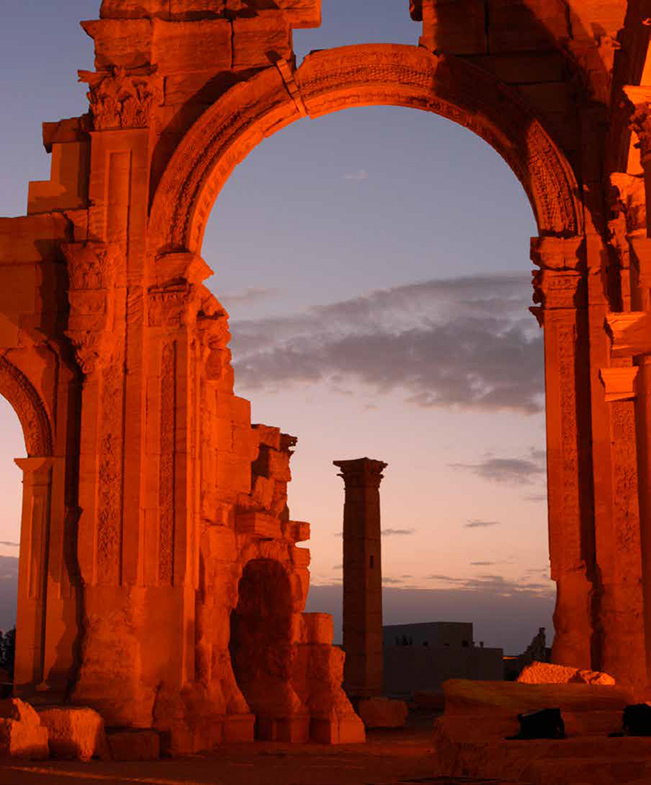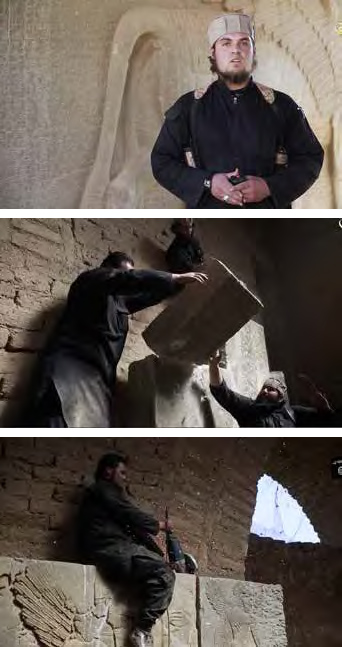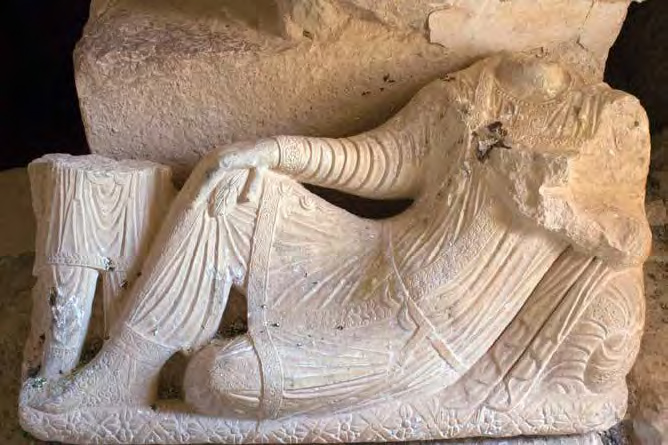Erasing History: Ancient Artifacts Destroyed
Published
Category
Author
Blog Post
By Clemens Reichel, Sascha Priewe, and Sheeza Sarfraz
It has become a cliché to say that “history is written by the victors,” but rarely does one note that it is not only written, but edited as well. Just as governments massage facts for the evening news and tightly control who speaks with whom when releasing information to the media, the lessons of history are changed and omitted at the pleasure of those holding the reins.
As far back as the reign of Thutmose the Third in ancient Egypt, and likely even before it, there are examples of artifacts being destroyed, not for the purpose of petty vandalism, but to eliminate names and faces from history—to erase the only records of a leader’s existence. Statues and murals depicting Queen Hatshepsut, the fifth pharoah of the eighteenth dynasty of Egypt, were damaged or demolished to remove her history and therefore her influence from Egyptian life. The Aztecs under Itzcoatl destroyed the codices of the peoples they conquered and replaced them with state-sanctioned history, controlling societies by rewriting their history. One simple, streamlined narrative serves a despot better than nuance and variety.
Headlines of the past decade have been littered with stories of the destruction of artifacts in political hot spots in Asia. Just as the Khmer Rouge had done in Cambodia decades before, the Taliban eradicated statues of the Buddha in Bamiyan, a UNESCO World Heritage Site, to erase the fingerprint of an Indian religion brought to Afghanistan long ago. Both Christian and Muslim forces have taken credit for the destruction of the Library of Alexandria, and both for the same reason: a war on “paganism.” Acts of this nature are not meant to imply supremacy of one religion over another; they erase the undesired religion altogether rather so that there is no debate.

Today we see ISIS (the so-called Islamic State of Iraq and Syria) forces laying waste to the ancient Roman city of Palmyra and the ancient Assyrian capital city of Nimrud. Although some of this destruction is possibly wanton vandalism, ISIS has within it an organization committed to the destruction of Muslim and non-Muslim artifacts, called the “committee for the promotion of virtue and prevention of vice.”
More than just an outcrop of extremist religious zealotry, the destruction of cultural heritage by ISIS clearly serves propogandist and ideological purposes. In this quest, ISIS’s path of destruction has not spared Muslim targets either—most of the buildings attacked by them so far are Islamic shrines. Their endgame is one of thought control. ISIS is destroying priceless artifacts and treasures to cement control over the message. History has taught us that no regime can last forever, which deepens the tragedy of artifact destruction, since it will always be for naught.
ISIS is defacing historical architecture and artifacts and slaughtering anyone who stands in their way. Only a few days back, Syrian archaeologist Khaled al-Asaad was murdered at their hands after he refused to reveal the location of artifacts excavated from Palmyra. As the global archaeological community deals with this new wave of cultural destruction in Palmyra, Sascha Priewe, Managing Director of Ancient Cultures, discusses the attacks on Palmyra with colleague Clemens Reichel, Associate Curator of Ancient Near East Culture at the ROM and Assistant Professor of Near and Middle Eastern Civilizations at the University of Toronto.
Interview conducted on August 31, 2015
Sascha Priewe: News from Syria has been dreadful for several years, but recently the number of reported atrocities has escalated: last week the murder of a senior archaeologist, now the detonation of a temple, both at Palmyra. You’ve worked in Syria for more than 20 years and now you’re spending your summer in Toronto and not in the field. Don’t you feel frustrated about this—how does this affect you?
Clemens Reichel: How does this affect me? The best way to describe it is probably a feeling of “homelessness.” It may sound strange nowadays, but for many years trips to Syria—often several per year—were as normal to me as visits to the shopping mall. Since 2004, I directed excavations at Hamoukar, a large site in northeastern Syria and early city that was destroyed by warfare around 3500 BC. For several months per year I therefore lived in Syria. The public understandably has terrible associations with Syria nowadays— looking at pictures of the devastation in the country and large number of refugees—but it was a great country with wonderful, very hospitable people, a great cuisine, and a rich, diverse history. As in all parts of the world, you had to separate politics from the people, but the Syria I knew will always be one of my favourite countries in the world.
S.P.: Palmyra, another world-famous archaeological and UNESCO World Heritage Site, has been in the news since last May after being occupied by ISIS. You visited Palmyra several times per year. What do you remember most fondly? How did you experience the site?
C.R.: On our trips from Damascus to Hamoukar we almost inevitably stopped in Palmyra—and pretty much for the same reason as caravans that stopped there thousands of years ago. A natural oasis with springs, it is conveniently located in the middle of the desert that covers much of southern Syria. Unsurprisingly, it became a crossroad of several important trade routes between Central Asia and the Mediterranean that later became known as the Silk Road. It is trade that made Palmyra’s wealth. Almost two millennia after Palmyra’s demise you can still relive the site’s geopolitical significance when you approach the modern city, called Tadmor. After a drive through monotonous desert landscape that lasts several hours (no matter from which direction you come), you suddenly see palm trees and gardens. If ever the significance of water can be appreciated, this is the place to do so. And then you see the ancient city with its shining colonnaded roads, temples, theatres, and markets. In midday they sparkle white in the heat. It is at sunrise or sunset, however, when it is doused in warm, orange sunlight, that the site looks the most impressive. A view of the site from the Ayyubid citadel (built circa 1230 AD) at these times of day—a favourite stop of mine when I guided tour groups through Syria—made it abundantly clear why many travellers continue to describe Palmyra as the most beautiful site in Syria and possibly the entire Middle East.
S.P.: Recent news from Palmyra shows that the concern for the safety of the site, following its capture by ISIS, was more than justified. Why is Palmyra important? Why should we care about the site?
C.R.: As I mentioned, the city’s wealth was founded on trade. Historical sources mention its name early on in the first millennium BC. By the first century AD, it had fallen under Roman influence, retaining a significant degree of autonomy. Greeks and Romans lived side-by-side with local Palmyrans (whose language is closely related to Aramaic), creating a truly cosmopolitan society. But Palmyra grew into much more than a trade colony. By the third century AD, Palmyra felt strong enough to take on Rome. In 270–271, during the reign of the legendary Queen Zenobia, its troops conquered the Levant, Egypt, and much of Anatolia. The Roman reply was swift: by 272 Zenobia was defeated—legend has it that she was taken to Rome in golden chains. At first the city itself was saved; following another rebellion in 273, however, it was reduced to rubble by Roman troops.
When you visit the site nowadays you realize, of course, how much has escaped the Roman destruction and you are left with a first-hand impression of the multicultural nature of this city. Its colonnaded streets, senate, and tetrapylon seem very Roman, but its agora (market) and theatre remind you of Greek cities. Looking closely at the columns, you may recognize Roman, Greek, and Egyptian elements, but there is also a distinct local style. This mix is also reflected in religious architecture. The majestic Temple of Bel, the great overlord of the Aramaic pantheon, with its columns and peristyle, looks like a Greek temple at first. In its layout, however, it functions very much like a Mesopotamian temple. This is what makes Palmyra so fascinating—a diversity that reflects an openness and internationalism.
S.P.: How much damage has ISIS done at Palmyra so far?

C.R.: News reports released before and during the seizure of Palmyra by ISIS mentioned the fact that numerous items of sculpture from the Palmyra Museum might have been evacuated by the antiquity authorities. That is commendable, but we should not be misled—you cannot move the essence of a site into a museum. Palmyran art is rife with depictions of gods and humans, especially in temples and tombs. In a statement released after the capture of the city ISIS emphasized its focus on the destruction of sculptures that they considered “pagan” and “blasphemous,” while claiming that the site and its buildings were going to be spared destruction. This is a “policy” which they applied during their devastation of Hatra, another World Heritage Site in northern Iraq, in March earlier this year. Well … at Palmyra they certainly made true on the first part of their statement by destroying several sculptures, including a famous lion figure and several statues that already had been smuggled out of the city, but last week it also became clear that they won’t spare the architecture. Their first target was the Baal Shamin Temple. Built during the second and third centuries AD, its graceful sanctuary at first looks like a typically Roman temple. A closer look, however, reveals uniquely Oriental traditions such as large windows in the site walls, and a mix of Corinthian and Egyptian tradition that highlight the cosmopolitan nature of the temple’s architectural and religious tradition. Photographs disseminated through social media and satellites images show how a major explosion has reduced this temple to rubble. This atrocity, heinous was at it was, was apparently dwarfed over the weekend, when they reportedly blew up the Temple of Bel. This was the principle house of worship at Palmyra and one of the most impressive and widely recognized buildings of ancient Syria. I hate to use such graphic parallels, but to a Near Eastern archaeologist it feels as if the Dome of St. Peter in Rome had just been blown apart … More than its military objectives, ISIS’s campaign against ancient heritage has been very successful. Their vandalism at Hatra, Nimrud and now Palmyra has wiped out some of the key monuments in Syria and Iraq, and we have to anticipate that they are far from finished. The fact that ISIS also sells artefacts looted from museums and archaeological sites highlights this group’s schizophrenic relationship with antiquities: it makes money by selling the very things that it has pledged to destroy.
S.P.: ISIS is committing atrocities against people and many people were murdered in Palmyra following the fall of the city. In light of the tremendous loss of human life in the Syrian conflict, can we rightly lament the loss of a few ruins, a sentiment voiced regularly when ISIS’s destructions make headlines?
C.R.: They don’t compare—and putting antiquities over human life is unconscionable and a suggestion that any decent human being will reject. But the question bothers me because of its materialistic undertones. Human life is irreplaceable, as is cultural heritage. You destroy it, it’s gone—it won’t grow back. I can’t (and won’t try to) put a dollar value on what is potentially to be lost in Palmyra or other sites in Syria or Iraq. What’s the point if we can never replace it?
More to the point, the juxtaposition of “human life versus antiquities” trivializes the sacrifice of our Syrian and Iraqi colleagues who continue to do their work at great personal risk. As you hinted at earlier on, last week saw the brutal murder of 82-year-old Khaled al-Assad, an eminent Syrian archaeologist and expert on Palmyra, by ISIS. News outlets all over the world reported in graphic detail how, in spite of being tortured, he refused to give out information concerning the whereabouts of artifacts from the site. The murder of a respected colleague shakes me up, and I condemn this cowardly act in the strongest possible terms. At the same time I have to respect his courage and commitment—he didn’t leave Palmyra, he stood up for his lifetime’s work. Would any of us have been brave enough to do the same?
S.P.: Could you tell me about the ROM’s connection to Palmyra?
C.R.: The ROM has not directly worked at Palmyra, but we are fortunate to own three funerary stela, which are on display in the Joey and Toby Tanenbaum Gallery of Rome and the Near East. All three of them show images of the deceased—two women and a man—identified by name and and family affiliation. Their attire— the garments worn as well as the jewellery—make it clear that these people were part of Palmyra’s upper crust. A spindle whorl held by one of the women refers to gender-specific housework, but in her case may have been more symbolic.

If you visit the Palmyran sculpture, look at some of the videos in the portal installed next to them. In December 2010, I took a trip to Syria with ROM’s New Media department. We were given a royal treatment by the antiquities authorities and allowed to film with practically no impediment—not only in Palmyra, but also in many of the other sites in Syria that now are either destroyed or under threat. Back then, we had no idea what kind of a time capsule we were creating, but I am truly grateful that this footage exists.
S.P.: Now that looted Syrian and Iraqi works of art artifacts have started hitting the US art market, the London art market, and are claimed to appear on eBay, what can individuals like you and I do about it?
C.R.: Your first inclination might be to buy, and hence save, a piece of history. If you are thinking about it: don’t! ISIS has looted several museums and is in the process of systematically stripping archaeological sites for antiquities to fund their activities. To put it bluntly: by buying such antiquities you would be funding ISIS. You don’t want to do that, do you?
I am aware that many people are of the opinion that artifacts from troubled spots in the world such as Syria or Iraq are “better off” in Western museums. Just remember that such artifacts have already been looted—they have lost their archaeological context, and much data such as pottery, biological, botanical, and C14 samples that would have been useful to date and contextualize an artifact are irretrievably destroyed.
We also will never know if an artifact from the antiquities market is really genuine or not. At best, we can date and place it based on properly excavated commodities—so we hardly ever This tomb figure, which shows a reclining Palmyrean citizen, once decorated the top of a sarcophacus. Many tomb sculptures taken to the Palmyra museum were saved before site was taken by ISIS. Those left on site, however, are at great risk of being destroyed. really learn anything from such pieces. You can help to monitor the market: if you notice a suspicious looking artifact, report it to Customs or the police. These agencies can decide who to contact for a professional opinion.
S.P.: What can museums do about this?
C.R.: What I said about individuals also applies to museums: this is not the time to relax acquisition policies for the purported purpose of “safeguarding” cultural heritage. The actions by ISIS cannot be countered by museums returning to a nineteenth-century collections mentality. We need to cooperate with our colleagues in Syria and Iraq irrespective of political creed, and we should be ready to engage in partnerships with local museums as time and logistics will (hopefully) allow us. Such partnerships could involve long-term loans of artifacts to a Western museum. Such programs could be mutually beneficial since the lending institution would not give up ownership, while the host institution would spend its resources on conservation and research as opposed to acquiring unprovenanced artifacts.


